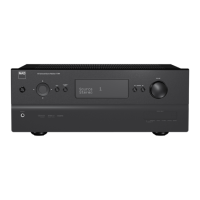AUTOMATIC PRESET
Preset stations may also be programmed automatically for the entire FM (or
AM) band.
1 Toggle the [AM/FM/DB] button to select FM (or AM) band.
2 Press and hold the AVR 3’s [MEMORY] button until the station frequency
indication begins to increase.
3 Release the button and note that the tuner will search the entire FM
(or AM) band, and stop briey at each station that has acceptable
signal strength. The T 747 will automatically assign a preset number to
each station, and then search for the next station. Up to 30 of the best
received FM stations (or 30 AM stations) will be automatically stored.
DELETING A STORED PRESET
You can empty a preset by deleting the stored information.
1 Select the preset number to be deleted.
2 While at the selected preset number, press the AVR 3’s [DELETE] button.
3 The preset will then be deleted and “DELETED” scrolls on the display.
4 To clear all the Presets at the same time, repeat step 2 again but this
time do not release the [DELETE] button. Press and hold [DELETE]
button until the current Preset number shown in the VFD is
extinguished (P--). All Presets are now deleted.
CHOOSING THE TUNER MODE
The AVR 3’s [TUNER MODE] key is a dual-purpose control. Toggle [TUNER
MODE] toggle to switch between FM Stereo mode or FM Mono. In the
normal position, “FM STEREO ON”, only the stations with a strong signal can
be listened to, and the noise between stations is muted.
Pressing the [TUNER MODE] button again (“FM STEREO OFF”) allows distant
and potentially noisy stations to be received. Noise is reduced if the FM
station signal level is less than the FM Stereo threshold (since mono FM is
inherently less noise-prone) though at the sacrice of the stereo eect.
ABOUT USER NAMES
You can assign an eight character “User Name” to each radio preset, which
will show in the front-panel readout whenever that preset is recalled.
ENTERING USER NAMES
To name a radio preset “NEWS”, follow the procedure as below.
1 Recall the desired radio preset.
2 Then, press and hold [INFO] of the AVR 3 until the display shows a
ashing cursor point.
3 Use the [ ] buttons to select the rst character of the name (“N”
from the alphabetical list).
4 Press [ ] button to select the character and correspondingly move
forward to the next position. (Press [ ] to go back to the previous
character). Repeat this process for each character in sequence.
5 Press the [MEMORY] key again to store the User Name and exit the text-
entry mode.
ABOUT RDS
The Radio Data System (RDS) permits sending small amounts of digital
information using conventional FM radio broadcasts. The T 747 supports
two RDS modes, station-name (PS mode) and radio-text (RT mode). Not
every FM station incorporates RDS in its broadcast signal. In most areas you
will nd from one to several RDS-enabled stations, but it is by no means
impossible that your favorite stations will not be broadcasting RDS data.
VIEW RDS TEXT
When an RDS-enabled FM broadcast is tuned, the readout’s character section
will show its station-name (PS) text: “ROCK101”, for example.
Press the AVR 3’s INFO key to toggle the readout between this and the station’s
radio-text (RT) readout, if any, which might scroll song- or artist-name, or any
other text of the station’s choosing.
OPERATION
LISTENING TO AM/FM RADIO
33
ENGLISHFRANÇAISESPAÑOLITALIANODEUTSCHNEDERLANDSSVENSKAРУССКИЙ

